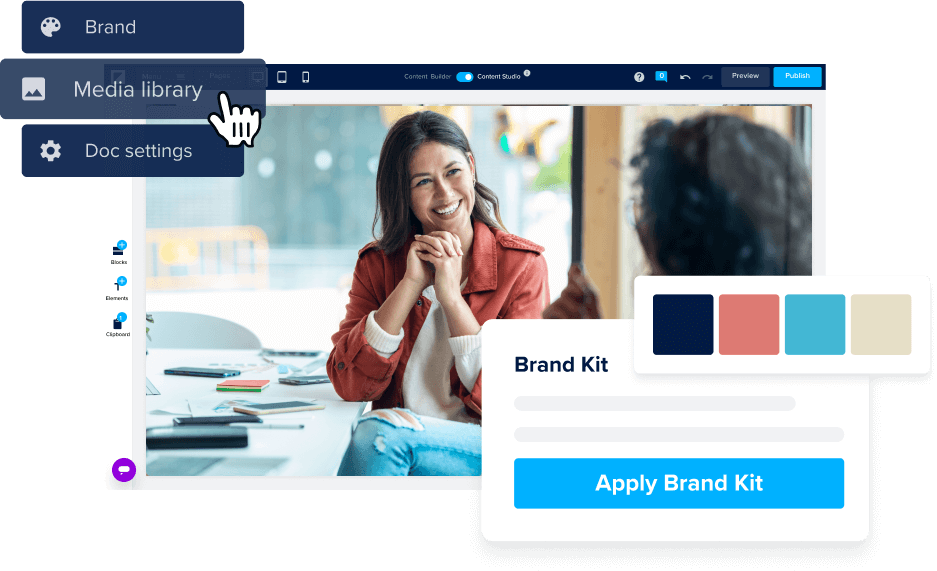For content marketers, staying ahead of the curve isn't just part of the job; it’s what keeps our audiences engaged and helps us stay relevant. Let's be clear: this isn't about jumping on every trend bandwagon.
A great content marketing strategy isn't trend-dependent, but it's agile enough to embrace trends that align with our brand and audience. Content marketing trends offer clear direction and provide an excellent way to understand your brand's current and future direction. They can enhance brand value, which is crucial to staying fresh and relevant.
So, without further ado, let’s delve into the trends shaping up to be big in 2025 and those we're ready to leave behind.
Storytelling is in. Generic content is old news.
Humans are empathic creatures. We ultimately want to feel a sense of connection. Against the rise of AI-generated content, storytelling has become an even more crucial differentiator for brands. Essentially, all communication touchpoints should tell a captivating story. A good story will resonate, cultivating emotion and a sense of togetherness. If you think about it, stories are intrinsic to humanity. Research indicates compelling storytelling can foster empathy and stronger connections between a brand and its target audience.
The purpose of all content marketing should be to reward your audience with highly valuable information that can help them achieve better business outcomes. When used correctly, storytelling can convey your brand's values, mission, and identity using the power of narrative. It helps you make it to the hearts of your audience and create an emotional connection.
Audiences today need authentic, narrative-driven content that resonates with their emotions and values.
What's out: Generic, one-size-fits-all content has lost its appeal. Audiences these days are no longer satisfied with bland, impersonal messaging. It's time to bid farewell to content that lacks a unique narrative or fails to engage on a personal level. This shift means we’re not churning out a high volume of sub-par content but focusing more on high-quality content.
Our takeaway: Interactive content generates significantly more engagement (53%) than run-of-the-mill content. In the future, The best content must focus on user needs and present the information in an engaging format t
Automation is in. Overreliance on AI is out.
In times of economic uncertainty, it is usually the departments that are unable to prove their ROI that are first to receive budget cuts. So, teams are often tasked with 'doing more with less' for disciplines like content marketing, where efforts can be challenging to quantify. Here is where automation comes in as a knight in shining armor.
Whether it's automating email campaigns, content distribution, or data analysis, automation streamlines processes, saves time, and allows for more strategic creativity. It's a powerful tool to enhance efficiency.
What's out: Against the surge of readily available AI models, overreliance on AI will be a thing of the past as we advance. AI-generated content must include human writers' creative and unique aspects, often resulting in less engaging and distinct content. However, AI can be a helpful ally for marketing automation rather than creation.
Our takeaway: Don't sacrifice the human touch for the sake of automation. AI is a helpful tool, but content marketers must not rely on AI models for high-quality B2B content creation. Automation makes repetitive tasks less time-consuming, so you can focus on creating unique content for your audience.
Discover: How to Scale Content Production.
Hyperpersonalization is in. No more one-size-fits-all messaging.
Last year, it was all about personalization, and as we go forward, hyper-personalization will be all the rage. By hyper-personalization, we mean going beyond basic techniques, like using a customer name, to leveraging real-time data, artificial intelligence (AI), and machine learning to deliver more relevant content, product recommendations, and experiences.
According to Segment, 44% of consumers will likely become repeat buyers after a personalized shopping experience. As technology evolves, people expect content tailored to their needs and preferences. By leveraging data and AI, you can deliver content that speaks directly to each customer, enhancing overall engagement and boosting conversion rates.
What's out: This demand for hyperpersonalized content means that generic, one-size-fits-all messaging is going out of fashion fast. Sending the same content to your entire audience no longer cuts it. If you do one thing this year, bid farewell to mass messaging and embrace the power of personalization.
Our takeaway: As content marketers, creating the right content for your audience is one of our most significant challenges. Leveraging hyper-personalization is an excellent way to show your audience that you know their problems and have a solution.
Discover: Why Personalization Matters in Content Marketing
Video marketing is in. No more relying on traditional media.
From now on, video marketing will not just be a trend but also a crucial part of how businesses talk to their customers. Why? Because most people would rather watch a quick, fun video than read a long article.
As technology develops, the need for video content, not just product videos or ads, continues to grow. Think how-to videos, behind-the-scenes peeks, and enjoyable content for the viewer. This content connects with people and can often interest them in what a brand offers.
The numbers don't lie: 84% of respondents because of a brand’s video, and 93% of businesses on social media. That's huge! Plus, search engines like Google love videos, too. If your website has good videos, it's more likely to appear higher in search results.
What's out: The rise in video content means that brands that rely solely on traditional media channels like television and print are becoming outdated. The digital age demands a shift towards more dynamic and interactive video formats to capture today's audiences.
Our takeaway: Video marketing is essential as we advance. We could even go one step further to say creative video marketing is essential since generic content won’t hit the mark. It's all about creating content that catches the eye, provides value, and makes people want to learn more about what you're selling.
Discover: 6 Reasons Why You Should Stop Using PDFs for Business Content.
Voice search optimization is in. No more ignoring the data.
How we search for information is evolving, and voice search optimization is at the forefront of this change. As more people adopt devices with voice search features, e.g., smartphones, smart speakers, and virtual assistants, content must be tailored for voice queries. This means structuring content to answer questions people are likely to ask in a conversational tone.
What's out: Marketers who ignore the insights gained from analytics and user behavior miss opportunities to refine their content strategies. So, this year, we are saying goodbye to data neglect. Turning a blind eye to the wealth of data available is a no-go. Ignoring data means losing opportunities to fine-tune your content strategies and stay ahead.
Our takeaway: Understanding your audience, including how they search for information, is essential to improving your content marketing. Adapting your content to meet these habits is a big part of the job, and leveraging data from voice search can make a huge difference in how your content performs.
UGC is in. Overly polished content is over.
A trend that has been steadily on the rise for the past ten years, user-generated content (UGC) is taking center stage this year. We tend to trust real stories and opinions from people like us more than overly polished content. Brands encouraging and showcasing UGC, like customer reviews, photos, and videos, are tapping into that trust goldmine. By leveraging user-generated content, you demonstrate authenticity that professional shoots can't match.
What's out: Overly polished, highly produced content is losing appeal. People are more inclined to engage with authentic, relatable content. It's time to bid farewell to content that feels too staged and perfect. The era of high-budget content is fading. Audiences today are looking for something they can relate to, content that feels genuine. Perfect-looking content often feels disconnected from the everyday experiences of most customers. It's time to move away from this artificial perfection in favor of something more genuine and relatable.
Our takeaway: This year's all about showcasing real people using your products or services in their everyday lives. This builds trust and helps potential customers see how your products fit into their own lives. Focus on creating a space where customers feel encouraged to share their experiences. Ditch the 10K product video and invest in a user-generated content strategy.
Purpose-driven marketing is in. Self-promotion is out.
Purpose-driven marketing is all the rage this year. This strategy focuses marketing efforts around values that align with its core principles. In this socially connected world, consumers want to support brands that share their values and contribute positively to society. You'll find a stronger resonance with your audience if you authentically connect your purpose with your marketing efforts.
What's out: In contrast to the rise of purpose-driven marketing, self-promotion has been on its way out for some time now. You simply cannot focus solely on product features and benefits. Customers are looking for brands that stand for something beyond profit. It's time to abandon pure self-promotion and embrace a greater purpose. Without a broader, value-driven context, self-focused promotion is losing effectiveness. Customers are looking for more than just what a product can do; they want to know what a brand stands for.
Our takeaway: For brands, this means a shift in strategy. Integrating your company’s values and mission into your marketing narrative is essential. Showcasing how your products or services contribute to a greater good can create a deeper connection with your audience. This approach attracts customers who share your values and builds long-term loyalty and trust. In essence, purpose-driven marketing isn’t just about selling a product; it's about being part of a larger story that resonates with the values and aspirations of your customers.
Final thoughts
Trends are fuel for content marketers. They act as a guide for the creation of relevant and engaging content. By tapping into current content marketing trends, you can ensure your content resonates with what your audience is interested in. This relevance is crucial for capturing attention in the increasingly crowded digital landscape.
However, it's crucial to approach content marketing trends with a strategy. Blindly following every trend without considering brand relevance and audience alignment can lead to disjointed and ineffective content. The key is to identify trends that align with your brand’s values and audience interests and then creatively integrate these into the content strategy to add value to your audience.
In summary, embracing content marketing trends helps keep your content relevant and engaging with audiences, strategically using the momentum of these trends to enhance content visibility and impact.
Try infusing your content strategy with one (or all) of these trends and see what difference it makes to your content marketing performance.

.png?width=1600&height=1924&name=Content%20marketing_%20Whats%20in%20and%20out%20in%202024%20(2).png)


